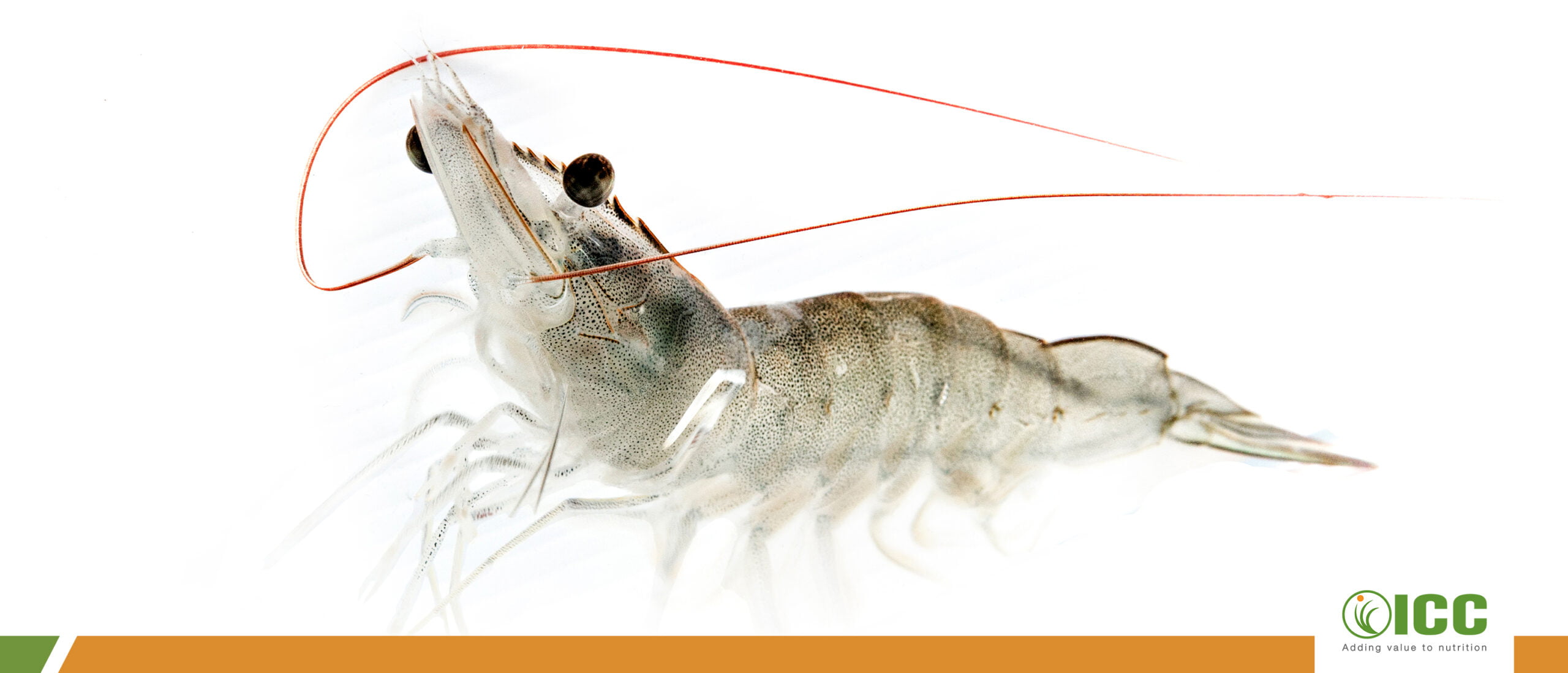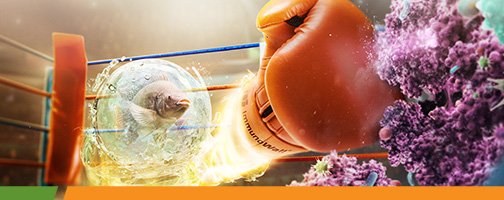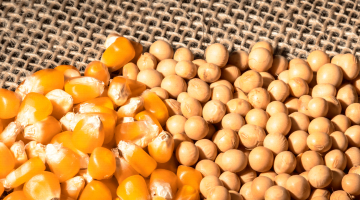The relation between immunity and productivity for the Whiteleg Shrimp (Litopenaeus vannamei)
Due to having such a sensitive organism, early mortality of the whiteleg shrimp is attributed to poor immunity
According to a study conducted by ICC Brazil, the early mortality syndrome (EMS), also known as acute hepatopancreatic necrosis syndrome (AHPNS), is a dangerous disease caused by the Vibrio parahaemolyticus bacteria.
After being first reported in China, back in 2009, EMS has spread throughout Vietnam, Malaysia, Thailand, and Mexico, causing an annual loss of more than US$ 1 billion. EMS outbreaks usually occur within the first 30 days after newly-hatched shrimp ponds are created, and mortality may exceed 70%.
The disease is transmitted orally, and the bacterium colonizes the shrimp gastrointestinal tract by producing a toxin that destroys the tissue and causes dysfunction in the digestive organ, known as hepatopancreas.
This study aims to evaluate ImmunoWall®’s effects as an additive able to reduce the impact of the Vibrio parahaemolyticus bacteria, which is the EMS agent in young whiteleg shrimps (Litopenaeus vannamei).
Research
3 treatments were conducted in the study
- Standard commercial food for shrimp (Litopenaeus vannamei).
- Commercial food with 5 kg of ImmunoWall® per metric ton of food.
- Commercial food with 10 kg of ImmunoWall® per metric ton of food.
Healthy shrimps (PL8) were bought from a commercial hatchery in the province of Chachoengsao. Before starting the study, the shrimps had 5 days to adapt to the tank. The PL12 shrimp was placed in a 100 L glass aquarium, with the salinity of 20 ppt. The initial population density was of 180 PL12 shrimp per aquarium (360 ind./m²). The feeding frequency was four times a day, at 7 a.m., 11 a.m., 3 p.m., and 7 p.m.
The composition is similar to the study food, such as moisture, protein, lipid, fiber, and ashes.
Tolerance to temperature stress and salinity
Shrimps were transferred to the study tank to test tolerance to temperature stress at 35 °C. Each treatment presented four repetitions with 10 shrimps each. The temperature was continuously increased up to 35 °C and controlled at this level. The mortality rate was registered daily for 10 days.
Tolerance to salinity stress study was carried out in 35 ppt. Shrimps were transferred to the test unity and raised under these conditions. Each treatment presented three repetitions with 15 shrimps by repetition. The mortality rate was registered daily for 10 days.
Challenge with Vibrio parahaemolyticus
After 30 days from the initial period, shrimps from each treatment were transferred to the challenge aquarium, with a population density of 20/aquarium. Each treatment was repeated four times. The virulent bacterium, Vibrio parahaemolyticus, was introduced by immersion treatment to determine the shrimp’s ability to resist against the pathogenic vibrio.
Cultivation of Vibrio parahaemolyticus
One day before the challenge, the Vibrio parahaemolyticus bacterium was cultivated in a nutrient culture medium with NaCl at 1.5% (p/v). Thirty hours after the cultivation, the culture medium was centrifuged to the collection of the bacterial cell. The pathogen was washed 2-3 times and adjusted to 1012 before use.
Immersion treatment
The challenge test with Vibrio parahaemolyticus was studied by immersion treatment under normal conditions and salinity stress conditions for one day before the challenge.
Eight shrimps from each treatment were randomly collected and transferred to the breeding facility in a 50 L aquarium with 20 L water level and 20 ppt seawater (salinity) for normal condition.
The challenge was repeated 4 times per treatment, with 20 shrimps per repetition. Shrimps were challenged by immersion treatment, with an infection dose of 1.0-2.9 x1012 CFU/mL. Strong aeration was supplied to the water during the challenge period.
The mortality rate was registered daily for 10 days after five days of challenge, Vibrio spp. Bacteria in the hepatopancreas of each group were counted by TCB agar to confirm the contamination by the pathogen and the shrimp’s immunity to fight against this bacterium.
For salinity stress condition and immersion challenge, 45 shrimps from each treatment were transferred to 50 L aquarium, with 20 L water level and 5 ppt seawater. The challenge test was repeated 4 times per treatment, with 15 shrimps per repetition.
Shrimps were challenged by immersion treatment, with an infection dose of 3.0-3.5 x1012 CFU/mL. Strong aeration was supplied to the water during the challenge period.
After five days of challenge, Vibrio spp. Bacteria in the hepatopancreas of each group were counted with TCB agar to confirm the contamination by the pathogen and the shrimp’s immunity to fight against this bacterium.
This study was conducted with a completely randomized design. All data were analyzed by one-way ANOVA (analysis of variance). Duncan’s Multiple Range Test was used to determine differences between treatment averages. The entire research was conducted at the Nutrition and Aquafeed Laboratory, Department of Aquaculture, Faculty of Fisheries, Kasetsart University, Bangkok, Thailand.
Results
Results showed that there were no significant differences in shrimp mortality after they were exposed to temperature and salinity stress conditions for 10 days. The high temperature of 35 °C induced mortality in the first four days. After that, the shrimp tolerated this high-temperature condition. Regarding the salinity stress, all shrimps survived under the conditions proposed. This means that the shrimp can adapt its physiology in an environment with high salinity.
ImmunoWall® effects on the resistance of diseases for Whiteleg shrimps (Litopenaeus vannamei), using the immersion treatment, are significant. Moreover, they showed differences after the Vibrio parahaemolyticus challenge under normal conditions and salinity stress.
Under normal conditions, the mortality rate in the control group was greater than in the shrimp group fed with ImmunoWall®. The count of Vibrio spp. in the shrimps’ hepatopancreas after the whiteleg shrimp challenge showed that the shrimp group fed with 1% ImmunoWall® showed improved hemolymph ability to fight against virulent bacteria, followed by the 0.5% ImmunoWall® group and control group, respectively.
Under 35 ppt stress conditions, shrimp’s mortality after the Vibrio parahaemolyticus challenge showed significant difference. Shrimps fed with ImmunoWall® had less mortality. The count of Vibrio spp. in the shrimps’ hepatopancreas after challenge showed that the shrimp group fed with a 1% ImmunoWall® diet showed improved hemolymph ability to fight against virulent bacteria, followed by the 0.5% ImmunoWall® group and control group.
Conclusion
ImmunoWall® demonstrated to be able to reduce mortality of Whiteleg Shrimp (Litopenaeus vannamei) when exposed to temperature stress, high salinity, and/or immersion with Vibrio parahaemolyticus, which is the EMS agent.
The best results were obtained with ImmunoWall® for inclusion levels during high salinity stress (35 ppt). As Vibrio parahaemolyticus is a halophilic bacterium, it develops and proliferates best in medium to high salinity. The immunomodulatory activity of the group fed with ImmunoWall® increased shrimp’s survival by 50% when compared to the control diet group.
For more information, contact us.
Posted in 10 October of 2019


